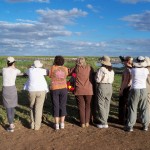 We’ve had a meaningful and fast paced last few days of our tour, first visiting Khajuraho, and then to Varanasi. We left Agra by train, and continued to Occhra to visit a fort. This huge palace, hand carved and built for one of the kings, was used by him only for one night. That’s it! The day we saw it, they were filming a movie there called Trees Speaking. Not sure if we got the title right but we asked our guide a few times and this is all we got. Watch for it coming to a theater soon. Rudyard Kipling (Jungle Book) stayed at the guest house at this palace for a while. Glad it got some use, since the King obviously didn’t get his money’s worth after building it.
We’ve had a meaningful and fast paced last few days of our tour, first visiting Khajuraho, and then to Varanasi. We left Agra by train, and continued to Occhra to visit a fort. This huge palace, hand carved and built for one of the kings, was used by him only for one night. That’s it! The day we saw it, they were filming a movie there called Trees Speaking. Not sure if we got the title right but we asked our guide a few times and this is all we got. Watch for it coming to a theater soon. Rudyard Kipling (Jungle Book) stayed at the guest house at this palace for a while. Glad it got some use, since the King obviously didn’t get his money’s worth after building it.
Khajuraho was a hoot. Our “Kama Sutra Expert” showed us these uniquely carved temples (22 of them in all) built over a thousand years ago with tens of thousands of depictions of elephants, armies and sex, basically. Lots of questions and comments from the group…mostly from Barry.
Next we were off to Varanasi, the holiest city for Hindus. This is the place where the Ganges meets the Varuna River, and devout Hindus make pilgramages so that they can bathe in the Ganges, and many come to die here as well. Once a person has died, they march them through the streets of town and bring them down to the river banks to wash them and to have them creamated. We went to the cremation sight in the evening where several fires were burning. It is an erie feeling, and I was most concerned about seeing this on my trip. It is so foreign to what I know…what I have brought up with, that is was uncomfortable and scary, actually. Had it been our first stop in India, it would have been very hard to handle as our understanding of this country would not have unfolded yet. But by the time we had arrived here, and having had a lecture upon our arrival in Hinduism, we were somewhat prepared for what we were about to see.
The streets of Varanasi were filled with organized chaos, as is most of India. Walking down the street to get back to our bus, we walked in a single line as busses, cars, rickshaws, motorbikes, bicycles, livestock and mobs of people all were moving in various directions at different times. It was dizzying and provided sensory overload! Cows, goats, priests with bells, even a man walking with a staff followed by four huge geese were out in the streets walking with us. Crazy!
 Early this morning, we came back to this sight, and it was a very different scene at sunrise. The streets were not as crazy, and we saw the pre-dawn scene unfolding, just as it has for a thousand years. All along the sides of the roads there were people sleeping, right next to sleeping cows. Goats and dogs were walking along the side of the road, and a monkey here and there as well. Along the Ganges, people were bathing in this holy water. It is a ritual that has been performed throughout the ages. In this same water, people were washing clothes, washing themselves and still, cremations were going on. Priests were praying. Monks were doing yoga and dogs were barking at monkeys in the trees. It was a very enlightening scene, and one that I will never forget.
Early this morning, we came back to this sight, and it was a very different scene at sunrise. The streets were not as crazy, and we saw the pre-dawn scene unfolding, just as it has for a thousand years. All along the sides of the roads there were people sleeping, right next to sleeping cows. Goats and dogs were walking along the side of the road, and a monkey here and there as well. Along the Ganges, people were bathing in this holy water. It is a ritual that has been performed throughout the ages. In this same water, people were washing clothes, washing themselves and still, cremations were going on. Priests were praying. Monks were doing yoga and dogs were barking at monkeys in the trees. It was a very enlightening scene, and one that I will never forget. 
This afternoon, we visited the birthplace of Buddhism, which had its beginnings in Hinduism. We learned about its beginnings, and saw the place that Buddha himself spoke to his followers. For the record, he was not fat. He was well proportioned. The Far East, never having seen Buddha, they gave him a huge tummy as they portrayed him as a prosperous soul.
My random visual moment of the day was of the local watering hole. People came to get clean water. They came with buckets, jugs and canisters so that they could have water. They pumped the water from below. As they were filling up their buckets, a dog was standing on a table, at the top of the water supply, lapping up the water with his tongue, just as happy as he could be. So much for clean water.
We have been here now for two weeks. I took a nap this afternoon (we got up at 4:30 am to watch the sun rise over the Ganges) and my dream included livestock walking down the street, just like in the streets below. I think it’s time to leave.
Our experience here in India will be life-changing, no doubt. We’ve formed some opinions now, however the true picture of what we saw and did, and the images of the people, the poverty, and the magic will unfold as we look at photos and relive our experiences. India is not for the casual traveler. It’s exotic, thought provoking and incredible, all at the same time. But both Barry and I agree this was one of the most memorable places we have seen to date, and will stay forever in our minds and in our hearts.



























